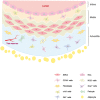Vascular Stem/Progenitor Cells in Vessel Injury and Repair
- PMID: 35224067
- PMCID: PMC8866648
- DOI: 10.3389/fcvm.2022.845070
Vascular Stem/Progenitor Cells in Vessel Injury and Repair
Abstract
Vascular repair upon vessel injury is essential for the maintenance of arterial homeostasis and function. Stem/progenitor cells were demonstrated to play a crucial role in regeneration and replenishment of damaged vascular cells during vascular repair. Previous studies revealed that myeloid stem/progenitor cells were the main sources of tissue regeneration after vascular injury. However, accumulating evidences from developing lineage tracing studies indicate that various populations of vessel-resident stem/progenitor cells play specific roles in different process of vessel injury and repair. In response to shear stress, inflammation, or other risk factors-induced vascular injury, these vascular stem/progenitor cells can be activated and consequently differentiate into different types of vascular wall cells to participate in vascular repair. In this review, mechanisms that contribute to stem/progenitor cell differentiation and vascular repair are described. Targeting these mechanisms has potential to improve outcome of diseases that are characterized by vascular injury, such as atherosclerosis, hypertension, restenosis, and aortic aneurysm/dissection. Future studies on potential stem cell-based therapy are also highlighted.
Keywords: aortic aneurysm; atherosclerosis; hypertension; restenosis; vascular injury; vascular remodeling; vascular stem cells.
Copyright © 2022 Tao, Cao, Yu and Qu.
Conflict of interest statement
The authors declare that the research was conducted in the absence of any commercial or financial relationships that could be construed as a potential conflict of interest.
Figures



Similar articles
-
Vascular Stem/Progenitor Cell Migration and Differentiation in Atherosclerosis.Antioxid Redox Signal. 2018 Jul 10;29(2):219-235. doi: 10.1089/ars.2017.7171. Epub 2017 Jul 5. Antioxid Redox Signal. 2018. PMID: 28537424 Review.
-
Progenitor cells in vascular repair.Curr Opin Lipidol. 2007 Oct;18(5):534-9. doi: 10.1097/MOL.0b013e3282a66082. Curr Opin Lipidol. 2007. PMID: 17885424 Review.
-
The Microenvironment That Regulates Vascular Wall Stem/Progenitor Cells in Vascular Injury and Repair.Biomed Res Int. 2022 Jul 31;2022:9377965. doi: 10.1155/2022/9377965. eCollection 2022. Biomed Res Int. 2022. PMID: 35958825 Free PMC article. Review.
-
Endothelial repair by stem and progenitor cells.J Mol Cell Cardiol. 2022 Feb;163:133-146. doi: 10.1016/j.yjmcc.2021.10.009. Epub 2021 Oct 29. J Mol Cell Cardiol. 2022. PMID: 34743936 Review.
-
Vascular stem/progenitor cells: current status of the problem.Cell Tissue Res. 2015 Oct;362(1):1-7. doi: 10.1007/s00441-015-2231-7. Epub 2015 Jul 14. Cell Tissue Res. 2015. PMID: 26169302 Review.
Cited by
-
Vascular Mesenchymal Stromal Cells and Cellular Senescence: A Two-Case Study Investigating the Correlation Between an Inflammatory Microenvironment and Abdominal Aortic Aneurysm Development.Int J Mol Sci. 2024 Nov 21;25(23):12495. doi: 10.3390/ijms252312495. Int J Mol Sci. 2024. PMID: 39684205 Free PMC article.
-
Therapeutic Strategy of Mesenchymal-Stem-Cell-Derived Extracellular Vesicles as Regenerative Medicine.Int J Mol Sci. 2022 Jun 9;23(12):6480. doi: 10.3390/ijms23126480. Int J Mol Sci. 2022. PMID: 35742923 Free PMC article. Review.
-
The Impact of Modern Anti-Diabetic Treatment on Endothelial Progenitor Cells.Biomedicines. 2023 Nov 14;11(11):3051. doi: 10.3390/biomedicines11113051. Biomedicines. 2023. PMID: 38002051 Free PMC article. Review.
-
Intersecting Pathways: The Role of Metabolic Dysregulation, Gastrointestinal Microbiome, and Inflammation in Acute Ischemic Stroke Pathogenesis and Outcomes.J Clin Med. 2024 Jul 21;13(14):4258. doi: 10.3390/jcm13144258. J Clin Med. 2024. PMID: 39064298 Free PMC article. Review.
-
Adipose-Derived Stem Cells to Treat Ischemic Diseases: The Case of Peripheral Artery Disease.Int J Mol Sci. 2023 Nov 25;24(23):16752. doi: 10.3390/ijms242316752. Int J Mol Sci. 2023. PMID: 38069074 Free PMC article. Review.
References
Publication types
LinkOut - more resources
Full Text Sources

